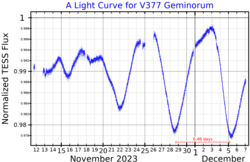 A light curve for V377 Geminorum, plotted from TESS data,[1] with the 6.46 day rotation period shown in red, | |
| Observation data Epoch J2000 Equinox J2000 | |
|---|---|
| Constellation | Gemini[a] |
| Right ascension | 07h 49m 55.05s[2] |
| Declination | 27° 21′ 47.45″[2] |
| Apparent magnitude (V) | 6.92[3] |
| Characteristics | |
| Evolutionary stage | Main sequence[4] |
| Spectral type | G5V[4] |
| Variable type | BY Draconis[5][6] |
| Astrometry | |
| Radial velocity (Rv) | −16.07±0.13[3] km/s |
| Proper motion (μ) | RA: −10.0268±0.0846 mas/yr[3] Dec.: −11.3143±0.0487 mas/yr[3] |
| Parallax (π) | 44.6848 mas[7] |
| Distance | 73.035±0.073 ly (22.4035±0.0225 pc)[3] |
| Absolute magnitude (MV) | 5.19[8] |
| Details[9] | |
| Mass | 0.99±0.03 M☉ |
| Radius | 0.912±0.034 R☉ |
| Luminosity | 0.753±0.026 L☉ |
| Surface gravity (log g) | 4.52±0.05[4] cgs |
| Temperature | 5640±74 K |
| Metallicity [Fe/H] | 0.03±0.05[4] dex |
| Rotation | 6.45±0.05 d |
| Rotational velocity (v sin i) | 7.3±0.3 km/s |
| Age | 414±23 Myr |
| Other designations | |
| Database references | |
| SIMBAD | data |
HD 63433 (TOI-1726, V377 Geminorum) is a G-type main sequence star located 73 light-years from Earth in the zodiacal constellation Gemini,[9][a] visually close to the star Pollux.[7] It has nearly the same radius and mass of the Sun, hence being classified as a Sun-like star.[9] However, it is much younger than the Sun, less than one tenth as old with an age of about 400 million years.[9][b] With an apparent magnitude of 6.9, it is not visible to the naked eye, but can be seen with a small telescope[11] or binoculars.[12] Based on its kinematic, rotational and lithium abundance properties, it is part of the Ursa Major Moving Group.[9] There are three exoplanets orbiting it, one is classified as an Earth-sized planet, while the two others are mini-Neptunes.[4]
- ^ Cite error: The named reference
MASTwas invoked but never defined (see the help page). - ^ a b Cite error: The named reference
GaiaDR3was invoked but never defined (see the help page). - ^ a b c d Cite error: The named reference
NASA Exoplanet Archivewas invoked but never defined (see the help page). - ^ a b c d e Cite error: The named reference
Capistrant2024was invoked but never defined (see the help page). - ^ Cite error: The named reference
Notsu2017was invoked but never defined (see the help page). - ^ Cite error: The named reference
AAVSOwas invoked but never defined (see the help page). - ^ a b c d Cite error: The named reference
SIMBADwas invoked but never defined (see the help page). - ^ Cite error: The named reference
Anderson_Francis_2012was invoked but never defined (see the help page). - ^ a b c d e Cite error: The named reference
Mann2020was invoked but never defined (see the help page). - ^ Cite error: The named reference
Bonanno2002was invoked but never defined (see the help page). - ^ Cite error: The named reference
Stellar Catalogwas invoked but never defined (see the help page). - ^ Cite error: The named reference
binocswas invoked but never defined (see the help page).
Cite error: There are <ref group=lower-alpha> tags or {{efn}} templates on this page, but the references will not show without a {{reflist|group=lower-alpha}} template or {{notelist}} template (see the help page).
